Swimming Pools
Economic Options: The Most Economical Swimming Pools
Turn your backyard dreams into reality with the most economical swimming pools that offer cost-saving options and customizable designs.
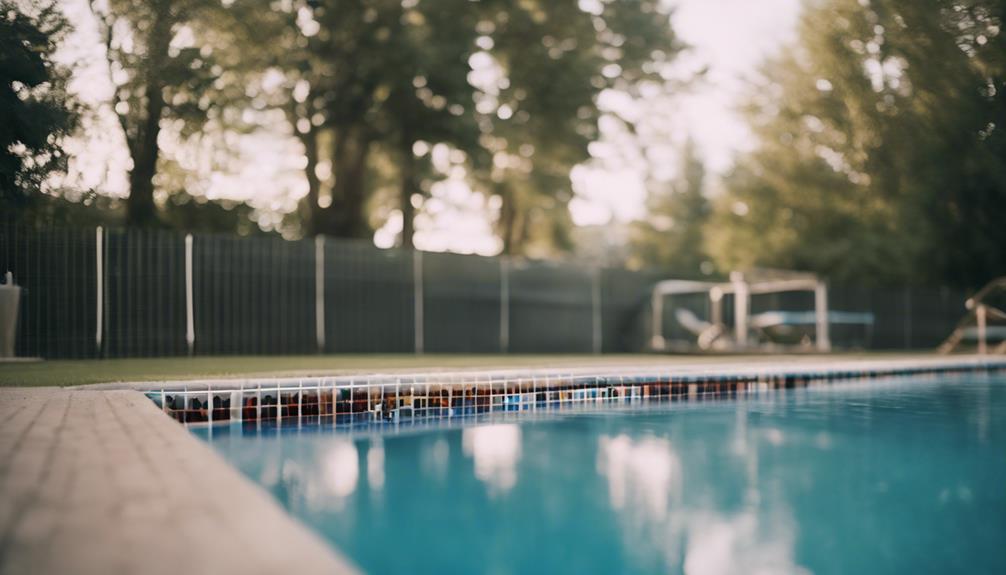
For the most economical swimming pools, consider vinyl pools with initial costs between $35,000 to $65,000. They offer customizable designs but need liner replacements every 4-7 years. Fiberglass pools are cost-effective with lower maintenance and lasting shells. Opt for smaller sizes to save on construction and upkeep, or choose semi-inground pools for budget-friendliness. Do your homework when hiring contractors, and explore DIY options to cut installation expenses. Learn more about energy-efficient features like LED lights and low-maintenance materials such as composite decking. Affordable accessories and simple pool designs can also help you save.
Key Takeaways
- Consider semi-inground pools for a budget-friendly option.
- Opt for fiberglass pools for cost-effectiveness and durability.
- Choose smaller pool sizes to reduce construction and maintenance costs.
- Research reputable pool contractors for competitive estimates.
- Prioritize energy-efficient features like LED lights and solar covers.
Vinyl Pools: Affordable Initial Costs
Vinyl pools offer homeowners an affordable option with initial costs ranging from $35,000 to $65,000. These inground pools provide a customizable solution where you can tailor the shape and design to match your preferences.
While the upfront prices are appealing, please be aware that vinyl liner pools, a popular type of vinyl pool, come with additional costs. These pools typically require liner replacements every 4-7 years, which can amount to $4,000 to $5,000 each time.
One challenge you may face with vinyl pools is algae growth. To combat this issue, regular pool maintenance is essential. By staying proactive with cleaning and chemical treatments, you can prevent algae build-up and ensure your pool stays clear and inviting.
Although vinyl pools are initially affordable, bear in mind that they may incur higher lifetime maintenance expenses. Factor in potential costs for upkeep and repairs to make an informed decision based on your budget and long-term financial plans.
Fiberglass Pools: Low Maintenance Expenses

Considering a different pool option? Fiberglass pools stand out for their low maintenance expenses compared to other types. Here are some key points to help you understand why fiberglass pools can be a cost-effective choice:
- Gel Coat: The gel coat on fiberglass pools acts as a protective barrier, reducing the likelihood of common pool issues that could require costly repairs and maintenance.
- Durability: Fiberglass pools are known for their durability, requiring fewer repairs over time and leading to overall lower maintenance costs.
- Pool Shells: The longevity of fiberglass pool shells can exceed a decade without needing replacement, offering significant cost savings in the long run.
- Limited Customization: While fiberglass pools may have limited customization options, this can actually lead to cost savings both during construction and maintenance.
- Cost Savings: Overall, the combination of reduced repair needs, durable materials, and limited customization can make fiberglass pools a smart choice for those looking to minimize long-term costs.
Concrete Pools: Versatile but Costly

Concrete pools offer a wide range of design options to suit your preferences.
However, be prepared for the hefty initial cost, ranging from $50,000 to over $100,000.
Despite their versatility, the long-term expenses for maintenance and resurfacing can add up over time.
Concrete Pool Costs
The construction of concrete pools typically incurs a cost ranging from $50,000 to $100,000, often exceeding the higher end of that range. When considering concrete pools, it's important to factor in the high costs associated with their installation and upkeep. Here are some key points to keep in mind:
- Concrete pools are known for their longevity but require regular resurfacing, adding to maintenance expenses.
- Maintenance of concrete pools is vital due to their susceptibility to algae growth.
- The versatility in design options for concrete pools comes with a price, as customization can increase overall costs.
- Concrete pools may not be compatible with salt chlorinators, potentially limiting your sanitation options.
- While concrete pools offer durability and design flexibility, it's crucial to budget for ongoing maintenance to ensure they remain in top condition.
Considering these factors, it's important to weigh the initial costs against long-term maintenance expenses when opting for a concrete pool.
Durability of Concrete
For those seeking a resilient and adaptable pool option, concrete pools present a durable choice despite their higher upfront costs. Concrete pools are known for their longevity, lasting for decades if properly maintained. However, the initial installation of concrete pools can be costly, ranging from $50,000 to over $100,000.
In addition to the pricey installation, concrete pools require regular resurfacing, adding to their long-term maintenance costs. While these pools offer versatile design options, they may not be compatible with salt chlorinators, necessitating the use of specific maintenance chemicals. Concrete pools are also prone to algae growth, requiring specialized cleaning to maintain water quality.
Despite these challenges, concrete pools remain a popular choice for those looking for a durable and customizable swimming pool option, provided that the necessary maintenance and care are consistently applied.
Researching Pool Contractors for Savings

When seeking economical swimming pools, save money by researching pool contractors for potential savings. Here are some tips to help you find the right contractor:
- Look for experienced and reputable pool contractors to guarantee quality work at a competitive price.
- Check customer reviews and ratings to gauge reliability and satisfaction levels.
- Request detailed estimates from multiple contractors to understand cost breakdowns and potential savings.
- Choosing the right pool contractor can lead to cost savings, efficient construction, and a durable swimming pool.
Opting for Smaller Pool Sizes
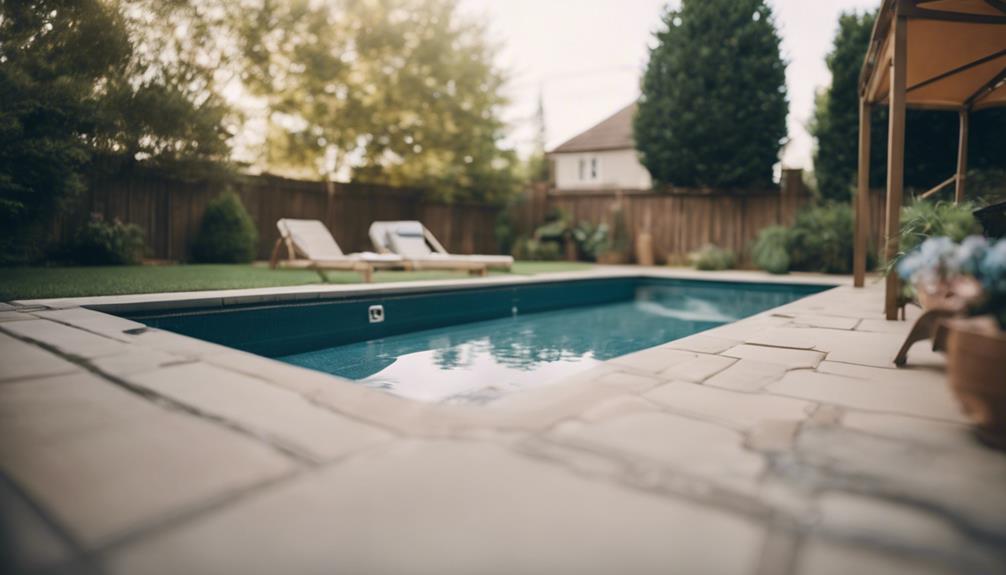
Consider opting for smaller pool sizes to enjoy significant cost savings in both construction and maintenance. When choosing a smaller pool, you can reduce construction costs by using fewer materials such as concrete, vinyl liners, or fiberglass. Additionally, smaller pools require less water, chemicals, and energy for heating and upkeep, leading to lower maintenance costs.
Despite their compact size, smaller pools can still offer functionality and aesthetic appeal with the right design elements. By focusing on the right design, you can create a visually appealing space that meets your needs while keeping expenses in check. Furthermore, smaller pools are often more energy-efficient and easier to manage due to their reduced water volume and surface area.
Semi-Inground Pools for Budget-Friendly Options

Semi-inground pools present a budget-friendly alternative to traditional inground options. These pools offer a cost-effective way to enjoy the benefits of a pool without breaking the bank.
Here are some key points to keep in mind:
- Cost-Effective: Semi-inground pools can cost much less than fully inground pools, with prices starting around $10,000-$20,000.
- Installation: The installation process is simpler and more affordable since it requires less excavation and materials compared to traditional inground pools.
- Affordable Customization: These pools can be customized with decking, landscaping, and other features to suit your preferences and budget.
- Benefits of Both Worlds: Semi-inground pools combine the advantages of above-ground and inground pools, offering a versatile and affordable swimming option.
- Budget-Friendly: With their lower price point and customizable features, semi-inground pools are an attractive choice for those looking to save money while still enjoying a pool.
DIY Construction Methods for Savings

To save on costs, explore DIY construction methods for creating economical swimming pools. By utilizing materials like wood pallets, hay bales, or stock tanks, you can achieve significant cost savings while still enjoying a rejuvenating dip in your backyard.
Popular DIY pool options include pallet pools, hay bale pools, and stock tank pools, all of which offer affordable pool solutions. These DIY pools can cost around $100 or even less to build, making them incredibly budget-friendly.
With a bit of creativity and effort, you can transform these simple materials into functional and enjoyable swimming spots. Wood pallets can be repurposed to construct a sturdy pool frame, hay bales can serve as inexpensive pool walls, and stock tanks make for convenient and durable pool basins.
Frequently Asked Questions
What Is the Most Affordable Type of Pool?
For the most affordable type of pool, go with a vinyl liner pool. Initial costs range from $35,000 to $65,000. It's a budget-friendly choice with lower maintenance costs compared to fiberglass and concrete pools.
What Is the Cheapest Pool Option?
For the cheapest pool option, consider vinyl liner pools as they typically start around $35,000. Opting for a smaller size or DIY installation can further reduce expenses. Fiberglass and concrete pools may cost more initially.
What Is the Best Reasonably Priced Pool?
For the best reasonably priced pool, compare initial costs, maintenance needs, and longevity of vinyl liner, fiberglass, and concrete pools. Vinyl liners start around $35,000, fiberglass $45,000, and concrete $50,000. Make an informed choice.
What Is the Most Economical Pool Design?
For an economical pool design, consider vinyl liner pools. They offer a cost-effective option, with initial prices ranging between $35,000 to $65,000. Fiberglass and concrete pools are pricier alternatives. Size, timing, and DIY can affect costs.
Conclusion
To sum up, it's worth noting that when it comes to selecting a cost-effective swimming pool option, vinyl pools offer the most budget-friendly initial costs, fiberglass pools come with lower maintenance expenses, and concrete pools offer flexibility at a higher price.
Conducting research on pool contractors and considering smaller pool sizes can also lead to cost savings. Additionally, a study by HomeAdvisor indicates that the average cost of installing a pool can range from $25,000 to $50,000, depending on the type and size chosen.
Take these factors into consideration to make a sound financial decision that aligns with your budget.
Swimming Pools
Revamp Your Backyard With Poolside Paradise
Nurture your backyard escape with Shoreline Pools' pool bar options, transforming your outdoor space into a luxurious oasis.

Elevate your outdoor oasis with Shoreline Pools' pool bar options, creating a resort-like atmosphere in your backyard. Swim-up bars, in-pool bars, and custom bar carts offer versatile choices for any space. Incorporate track lighting, weather-resistant materials, and unique design elements for a standout feature. Enjoy signature cocktails like Cucumber Margarita and Brewsky Sangria to enhance your poolside experience. Connect with Shoreline Pools for expert guidance on customizing your outdoor space with stone stools, countertops, and convenient bar carts. Discover how to transform your backyard into a luxurious poolside paradise with our stylish pool bar options.
Key Takeaways
- Elevate your outdoor space with poolside bars for a resort-like feel.
- Choose from swim-up bars, in-pool bars, or bar carts for customization.
- Incorporate unique design elements like track lighting and weather-resistant materials.
- Enjoy signature poolside cocktails like Cucumber Margarita and Pineapple-Sake Sangria.
- Connect with Shoreline Pools for expert guidance and innovative ideas to create your dream poolside paradise.
Poolside Bar Options
Plunge into a world of luxury and leisure by exploring the diverse poolside bar options available to elevate your backyard oasis. Adding a poolside bar can transform your outdoor space into a resort-like environment, perfect for entertaining family and friends during the summer months.
Modern pool bars come in various shapes and sizes, ranging from in-pool swim-up bars to poolside bars and flexible bar carts. Shoreline Pools specializes in customizing outdoor spaces to create the ultimate summer experience, ensuring that your pool bar is both functional and stylish.
Types of Pool Bars
Exploring the diverse options available, various types of pool bars can be integrated into outdoor spaces to elevate the ambiance and functionality of backyard retreats. Swim-up bars offer a true resort feel and are gaining popularity. Stone pool bar stools and countertops inside pools are appealing and convenient. In-pool bars can enhance outdoor kitchens and barbecue areas. Pool bar carts on wheels are ideal for smaller spaces. Building a pool bar from scratch allows for customization.
| Types of Pool Bars | Description |
|---|---|
| Swim-up Bars | Provide a resort feel and are increasingly popular |
| Stone Pool Bar Stools | Appealing and convenient inside the pool |
| In-Pool Bars | Enhance outdoor kitchens and barbecue areas |
| Pool Bar Carts | Ideal for smaller spaces and flexibility |
| Custom Pool Bars | Allow for complete customization |
Pool Bar Features

An important consideration when designing a pool bar is incorporating features that enhance both functionality and aesthetics. Adding a ceiling or overhang with track lighting can make the bar the focal point, while soft lighting underneath the bar can enhance the outdoor space.
Important features such as a sink, beverage chillers, and glassware storage guarantee convenience for hosting guests. Using weather-resistant materials is vital to withstand all elements and maintain the bar's quality over time.
Additionally, incorporating extra amenities and unique design elements can help create various outdoor themes, making the pool bar a standout feature in your backyard oasis. By focusing on these key features and amenities, you can elevate your poolside experience and entertainment capabilities.
Signature Poolside Cocktails
Introducing an array of invigorating and enticing cocktail options to complement your poolside oasis. These signature poolside concoctions are sure to enhance your outdoor entertaining experience.
Picture yourself lounging by the pool, sipping on a revitalizing Cucumber Margarita or indulging in the tropical flavors of a Pineapple-Sake Sangria with Jalapeno. For those who prefer a classic twist, a Rum and Tonic might be the perfect choice.
The zesty Strawberry-Lemon Mojitos and the unique Brewsky Sangria are also delightful options to explore. These handcrafted cocktails not only quench your thirst but also add a touch of sophistication to your poolside gatherings.
Elevate your backyard oasis with these signature poolside cocktails and let the flavors transport you to paradise.
Connect With Shoreline Pools
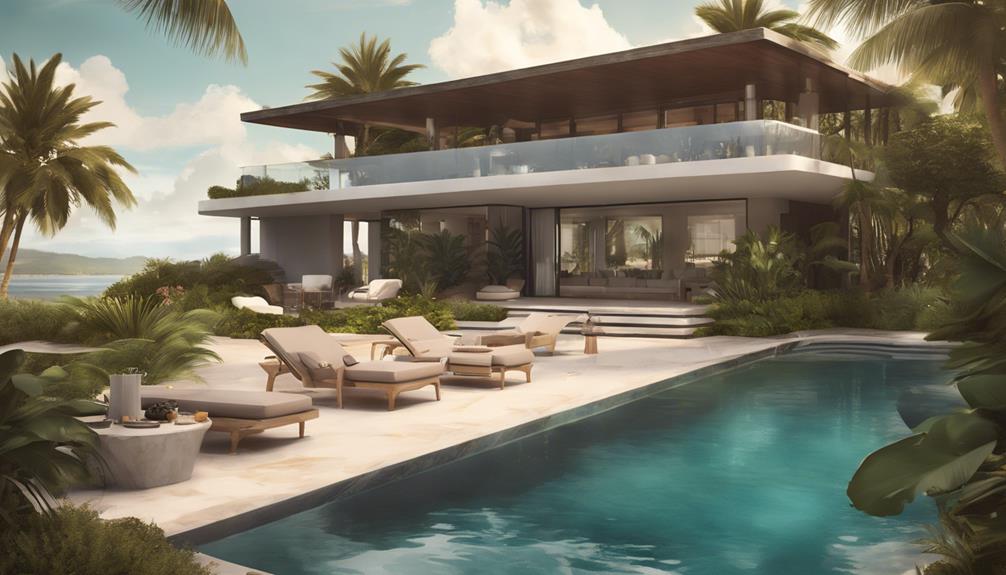
To initiate your journey towards transforming your outdoor area into a pool and bar lounge, consider reaching out to Shoreline Pools for expert guidance and innovative ideas.
Shoreline Pools specializes in customizing outdoor spaces to create the ultimate summer experience. Whether you envision a swim-up bar for a resort-like ambiance, a poolside bar with stone stools and countertops, or a convenient bar cart for smaller areas, Shoreline Pools can bring your vision to life.
Frequently Asked Questions
How Can I Maintain My Pool Bar During the Winter Months?
During winter months, maintain proper upkeep of your pool bar by protecting it from harsh weather conditions. Cover the bar area with a weatherproof tarp or fabric, store any glassware and equipment indoors, and regularly check for any damage to prevent deterioration.
Are There Options for Incorporating a Fire Feature With a Pool Bar?
Incorporating a fire feature with a pool bar can enhance ambiance and extend outdoor entertaining into the cooler months. Options include fire pits, fire tables, and fireplaces, providing warmth and a cozy atmosphere for gatherings.
Can I Customize the Design of My Pool Bar to Match My Home's Aesthetic?
Yes, you can customize the design of your pool bar to match your home's aesthetic. Incorporate materials, colors, and features that complement your home's style. Consider working with professionals like Shoreline Pools for a tailored and cohesive outdoor space.
What Are Some Creative Ways to Add Entertainment Features to a Pool Bar?
Enhance your pool bar with entertainment features like built-in sound systems, outdoor TVs, and cozy seating areas. Incorporate fire pits, water features, or outdoor games to create a versatile and enjoyable space for entertaining guests.
Do Pool Bars Require Special Permits or Approvals for Installation?
Creating a pool bar oasis may require special permits or approvals from local authorities. Regulations vary by location, so consult with your municipality or a pool construction professional like Shoreline Pools for guidance on the installation process.
Conclusion
To wrap up, transforming your backyard with a poolside bar can elevate your outdoor living experience to a new level of sophistication and relaxation.
Did you know that according to a survey by the Association of Pool and Spa Professionals, 87% of homeowners believe that having a pool increases the value of their property?
Consider adding a poolside bar to your outdoor space to create a luxurious oasis that will be the envy of your guests.
Swimming Pools
Hot Trends Cooking Up in Outdoor Kitchens
Feast your eyes on the latest trends in outdoor kitchens, from innovative cooking gear to stylish design elements – find out more about what's sizzling!

Explore the hottest trends in outdoor kitchens, from innovative cooking equipment like multi-burner stovetops and wood-fired pizza ovens to stylish design materials such as stainless steel and granite countertops. Refrigeration solutions offer sub-zero refrigerators and wine coolers for premium storage. Enhance your outdoor culinary experience with entertainment features like flat-screen TVs, outdoor speakers, and heating lamps for comfort. The latest trends include smart technology integration, eco-friendly choices, and modular kitchen setups for flexibility. Stay ahead of the curve and elevate your outdoor kitchen to new heights with these cutting-edge advancements.
Key Takeaways
- Smart technology integration for remote monitoring and control.
- Eco-friendly features such as solar-powered appliances.
- Modular kitchen setups for versatile outdoor cooking.
- Outdoor bars and beverage stations for entertaining guests.
- Sustainable materials like composite decking for eco-conscious design.
Cooking Equipment Innovations
The evolution of cooking equipment in outdoor kitchens showcases a shift towards high-performance features and customization options to elevate the culinary experience.
Multi-burner stovetops with high BTU outputs and precise temperature control are becoming increasingly popular for versatile cooking.
Colored grills offer a unique customization opportunity, adding a personal touch to outdoor cooking spaces.
Wood-fired pizza ovens are in demand for creating gourmet pizzas with a distinct smoky flavor.
Built-in deep fryers expand menu options, allowing for a variety of fried foods to be prepared outdoors.
Ice makers are also essential for crafting invigorating cocktails and keeping seafood dishes chilled, catering to a range of culinary preferences in outdoor kitchen design.
Stylish Design Materials
Stainless steel cabinets and granite countertops are prominent choices for adding a touch of luxury and durability to outdoor kitchen design. These materials not only provide a sophisticated look but also offer excellent resistance to the elements, ensuring longevity and easy maintenance.
| Design Material | Description | Benefits |
|---|---|---|
| Stainless Steel | Modern and sleek appearance | Weather-proof and durable |
| Granite Countertops | Luxurious and elegant | Scratch and heat resistant |
| Coordinated Furniture Sets | Consistent design aesthetic | Creates a cohesive look |
| Fireplace & Fire Table | Adds warmth and ambiance | Focal point for gatherings |
| Ceiling Fans | Enhances comfort and style | Provides cooling breeze |
Refrigeration Solutions
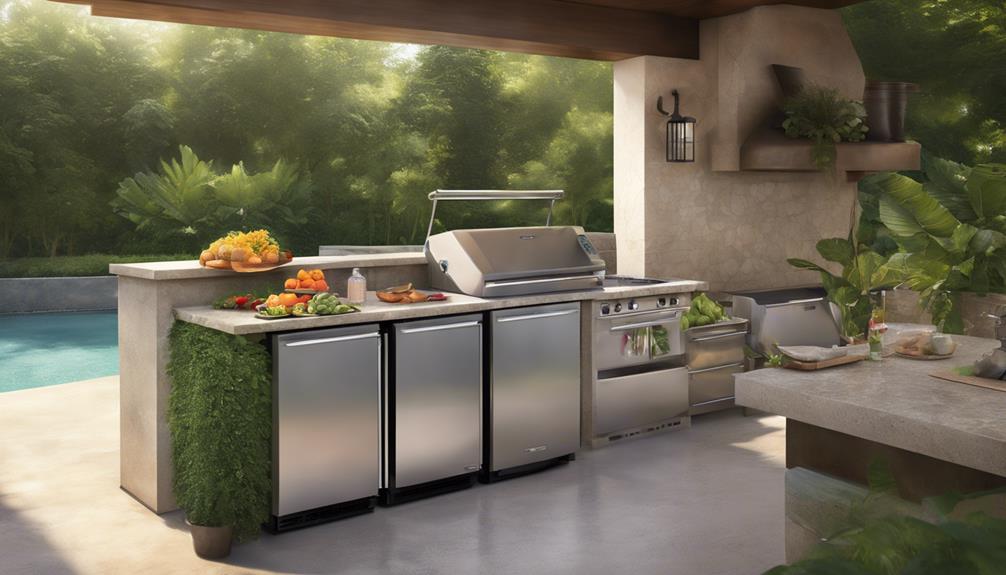
Prominent in outdoor kitchen design, refrigeration solutions play an essential role in ensuring the functionality and convenience of these culinary spaces.
When it comes to refrigeration trends, outdoor kitchens are now equipped with a range of innovative solutions:
- Sub-zero refrigerators for best storage of perishable items
- Wine refrigerators designed to preserve fine vintages at the ideal temperature
- In-place ice makers for easy access to ice for drinks and dishes
- Outdoor refrigerators that provide quick and convenient storage outdoors
- Upscale brand choices offering not only performance but also a touch of luxury and style to outdoor refrigeration units.
Entertainment & Comfort Enhancements
Enhancing the outdoor kitchen experience, entertainment, and comfort features are becoming increasingly popular in modern designs. As homeowners seek to create inviting and functional outdoor spaces, the incorporation of entertainment and comfort enhancements plays a key role. From flat-screen televisions for entertainment to high-quality sound systems for ambiance, outdoor kitchens are now equipped with a range of amenities to elevate the overall experience. Lighting not only enhances safety during food prep but also adds to the ambiance of the space. Heating lamps and lights provide warmth for chilly evenings, ensuring that the outdoor kitchen remains a comfortable gathering spot. Coordinated furniture sets further enhance the comfort and style of the outdoor kitchen area.
| Entertainment Features | Comfort Enhancements | Lighting |
|---|---|---|
| Flat-screen televisions | Heating lamps | Ambient lighting |
| High-quality sound systems | Coordinated furniture sets | Task lighting |
| Outdoor speakers | Plush seating | Decorative lighting |
Latest Outdoor Kitchen Trends
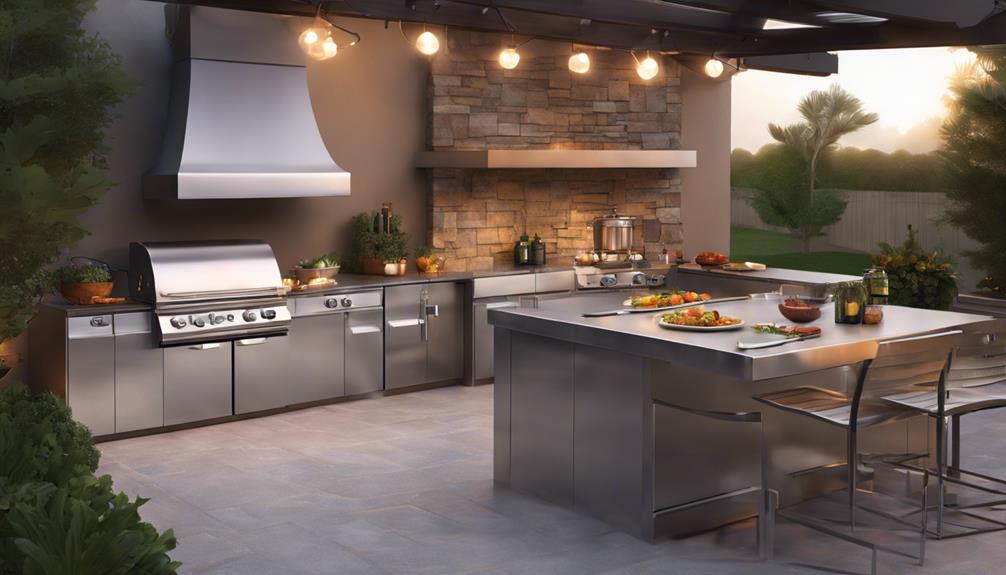
The evolving landscape of outdoor kitchen design is witnessing a surge in demand for cutting-edge cooking equipment and innovative design materials. Outdoor kitchens are now incorporating the latest trends to elevate the cooking and dining experience.
The most recent trends include:
- Smart technology integration for remote control and monitoring
- Eco-friendly features such as solar-powered appliances
- Modular kitchen setups for flexibility and customization
- Outdoor bars and beverage stations for entertainment
- Sustainable and low-maintenance materials like composite decking
These trends not only enhance the functionality of outdoor kitchens but also contribute to creating stylish and sustainable outdoor culinary spaces for homeowners to enjoy with family and friends.
Frequently Asked Questions
What Are the Maintenance Requirements for Outdoor Kitchen Equipment?
Maintaining outdoor kitchen equipment involves regular cleaning to prevent grease buildup, inspecting for wear and tear on components, ensuring proper storage during off-seasons, and scheduling professional maintenance for specialized items like refrigerators and wood-fired ovens.
How Can I Protect My Outdoor Kitchen From Harsh Weather Conditions?
To safeguard your outdoor kitchen from harsh weather conditions, confirm all equipment is made from weather-proof materials like stainless steel. Use covers for grills and appliances when not in use. Invest in a quality roof or canopy to shield the area from rain and sun damage.
Are There Any Eco-Friendly Options Available for Outdoor Kitchen Materials?
There are several eco-friendly options available for outdoor kitchen materials. Sustainable choices like reclaimed wood, bamboo, recycled plastic, and composite materials offer durability while minimizing environmental impact. These options blend functionality with eco-conscious design principles.
What Are Some Creative Ways to Incorporate Greenery Into the Outdoor Kitchen Design?
Incorporating greenery in outdoor kitchens can enhance aesthetics and promote sustainability. A study by the National Kitchen and Bath Association found that 78% of homeowners desire greenery in their outdoor kitchen design, showcasing a growing trend towards eco-conscious living.
How Can I Optimize Space in a Smaller Outdoor Kitchen Area?
To optimize space in a smaller outdoor kitchen area, focus on multifunctional equipment like compact grills with side burners, stackable storage solutions, and foldable furniture. Utilize vertical space for storage and consider a portable kitchen island for added workspace flexibility.
Conclusion
The evolution of outdoor kitchens is revolutionizing the way we cook and entertain outdoors. With cutting-edge cooking equipment, stylish design materials, refrigeration solutions, and entertainment enhancements, outdoor kitchens are becoming the epitome of luxury and functionality.
From gourmet dining experiences to ultimate relaxation, the latest trends in outdoor kitchens are setting a new standard for outdoor living spaces. Prepare to be amazed as outdoor kitchens transform into the ultimate culinary and entertainment paradise.
Swimming Pools
Make a Splash: Transform Small Backyards Now
Amplify your small backyard's charm with innovative design tips to create a stunning outdoor sanctuary.

Transform your compact backyard into a stunning outdoor haven with strategic design elements. Utilize vertical space solutions like plunge pools and maximize efficiency without compromising visual appeal. Creative water features, versatile furniture, vibrant greenery, and thoughtful lighting can transform your space into a tranquil retreat. Elevate ambiance, enhance functionality, and make the most of your outdoor area. With careful planning and the right elements, your small backyard can become a stylish oasis that you'll love.RuntimeObject Unleash the full potential of your outdoor space!
Key Takeaways
- Utilize vertical space with plunge pools for ground-saving solutions.
- Incorporate creative water features for visual appeal and relaxation.
- Opt for multi-purpose furniture to maximize functionality in small spaces.
- Enhance with vibrant greenery and privacy features for a tranquil retreat.
- Illuminate your small backyard with strategic lighting for ambiance and spaciousness.
Embrace Vertical Space Solutions
In small backyards, the strategic utilization of vertical space offers innovative solutions to enhance pool areas and create visually appealing outdoor environments. By installing sleek plunge pools that save ground space, homeowners can free up valuable square footage for lounging decks or seating arrangements.
Utilizing verticality in pool zone design not only maximizes space efficiency but also enhances the visual appeal of the area. This approach allows for the creation of visually stunning pool areas despite space constraints, offering a balance between functionality and aesthetics.
Embracing vertical space solutions opens up a world of possibilities for transforming small backyards into inviting and stylish outdoor retreats, where every inch is utilized wisely to create a harmonious and visually pleasing environment.
Install Creative Water Features
Utilizing creative water features in small backyards can elevate the ambiance and transform the outdoor space into a mesmerizing oasis. By incorporating alluring elements like cascading waterfalls or elegant fountains, you can enhance the visual appeal and create a tranquil atmosphere within your personal paradise.
These features not only add a touch of luxury but also help in maximizing the illusion of space by introducing striking visual elements that draw the eye upwards. The soothing sounds of flowing water further contribute to a relaxing environment, making your small backyard feel like a serene retreat.
Whether it's a small pond, a decorative fountain, or a series of waterfalls, creative water features can truly enhance the beauty and charm of your outdoor space.
Incorporate Multi-Purpose Furniture

Incorporating versatile furniture solutions maximizes functionality in small backyard spaces, offering practicality without compromising on aesthetics. Investing in dual-function furniture pieces allows for efficient use of limited space.
Hidden storage ottomans help declutter the area, while foldable tables and chairs provide flexibility for easy storage when not in use. These multi-purpose furniture items enable homeowners to maximize their backyard without sacrificing comfort or style.
Innovative designs cater to the specific needs of small areas, ensuring that every piece serves a dual role in enhancing the overall functionality of the space. By choosing furniture that is both practical and visually appealing, individuals can create a welcoming and efficient outdoor oasis within the constraints of a small backyard.
Enhance With Vibrant Greenery & Privacy
Enhancing small backyards with vibrant greenery and privacy features elevates both the aesthetic appeal and seclusion of the outdoor space. By adding lush greenery such as vertical gardens or hanging planters, you not only introduce natural beauty but also enhance privacy.
The presence of green accents softens the overall look, creating a welcoming and intimate oasis around your pool area. The strategic placement of plants helps in defining the space and providing a sense of enclosure.
Additionally, the incorporation of greenery contributes to a calming atmosphere, perfect for relaxation and unwinding. With careful selection and placement of plants, you can transform your small backyard into a tranquil retreat that offers both beauty and privacy.
Illuminate Your Small Backyard

Enhance the ambiance of your small backyard with strategically placed lighting fixtures. Illuminate pathways, seating areas, and water features with soft ambient lighting and accent lights.
As the sun sets, create a magical atmosphere in your outdoor space by incorporating pathway lights to guide the way and underwater lights to add a serene glow to your pool.
Highlight key elements like trees, plants, or sculptures with spotlights for added visual interest. By thoughtfully placing lights throughout your small backyard, you can expand visual boundaries, making the space feel larger and more inviting during the evening hours.
Let there be light in your outdoor oasis, transforming it into a mesmerizing retreat after dark.
Frequently Asked Questions
Can I Add a Fire Feature to Complement the Water Elements in My Small Backyard Oasis?
Adding a fire feature can complement water elements in your small backyard oasis. Consider a fire pit or a sleek fire bowl for warmth and ambiance. Balance the elements carefully to create a harmonious and inviting outdoor space.
How Can I Incorporate a Small Outdoor Kitchen or Bar Area Near My Pool?
Adding a small outdoor kitchen or bar area near your pool can enhance the functionality and entertainment value of your backyard oasis. Optimize space with compact appliances, multifunctional furniture, and stylish storage solutions.
Are There Options for Integrating a Sound System Into a Compact Pool Space?
Options for integrating a sound system into a compact pool space include waterproof Bluetooth speakers, in-wall or ceiling speakers, and hidden subwoofers. Choose high-quality, weather-resistant audio components to enhance your pool area with music and entertainment.
What Are Some Innovative Ways to Incorporate Recycled Materials Into My Backyard Design?
Innovative ways to incorporate recycled materials into your backyard design include repurposing old wood for decking, using reclaimed bricks for pathways, creating planters from recycled containers, and integrating salvaged metal for artistic accents.
How Can I Create a Sense of Depth and Spaciousness in a Small Backyard Pool Area?
To create a sense of depth and spaciousness in a small backyard pool area, utilize vertical space with sleek plunge pools, incorporate alluring water features like cascading waterfalls, opt for multi-purpose furniture, enhance with vibrant greenery, and strategically light the area for a magical ambiance.
Conclusion
To sum up, the transformation of small backyards into enchanting retreats demands strategic planning and creative design choices. By embracing vertical space, incorporating water features, utilizing multi-functional furniture, adding vibrant greenery, and enhancing with lighting, a magical oasis can be created.
Remember, 'good things come in small packages,' and with thoughtful consideration and innovative solutions, even the smallest outdoor spaces can be turned into inviting and visually stunning environments for relaxation and entertainment.
-

 Relaxation2 months ago
Relaxation2 months agoCreate a Relaxing Oasis: Top Poolside Lounging Ideas
-

 Vetted2 months ago
Vetted2 months ago15 Best Robot Vacuums for Pools to Keep Your Pool Sparkling Clean
-

 Health Benefits2 months ago
Health Benefits2 months agoDoes Swimming Pool Water Damage Teeth?
-

 Swimming Pools2 months ago
Swimming Pools2 months agoDo-It-Yourself: Inspiring DIY Swimming Pool Ideas
-

 Swimming Pools2 months ago
Swimming Pools2 months agoEntrepreneur's Guide: How to Start a Swimming Pool Business
-

 Pool Maintenance2 months ago
Pool Maintenance2 months agoMaster Chemical Balancing: Secrets to a Safe and Crystal-Clear Pool
-

 Swimming Pools2 months ago
Swimming Pools2 months agoDIY Fun: Homemade Swimming Pool Ideas
-

 Aesthetic and Design2 months ago
Aesthetic and Design2 months agoSmall Wonders: Small Garden Swimming Pool Ideas
















